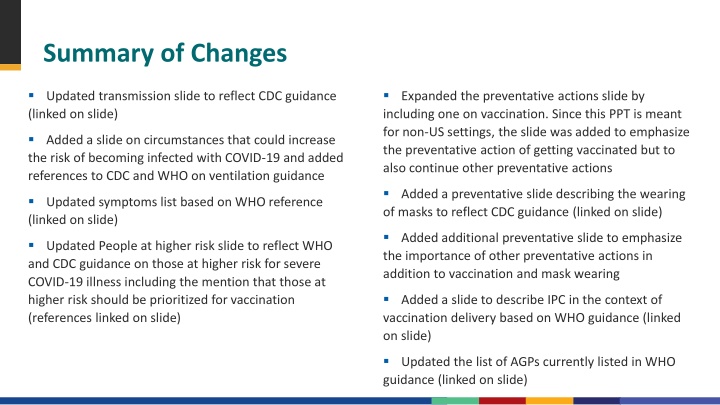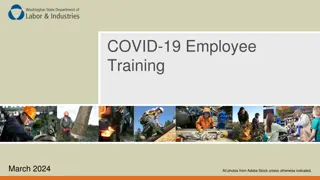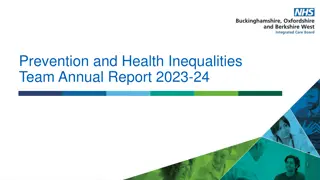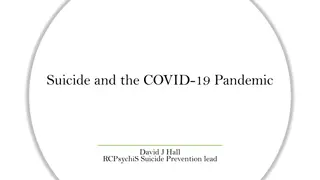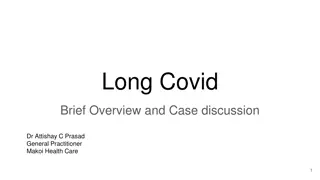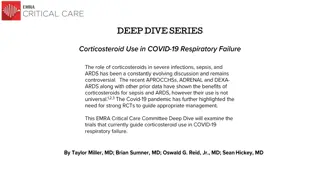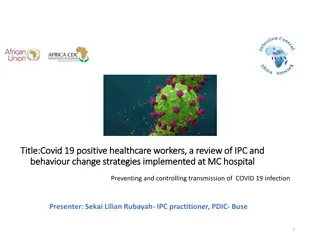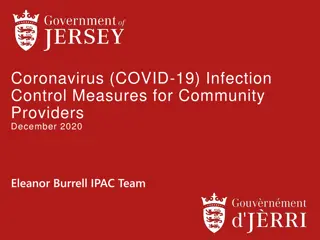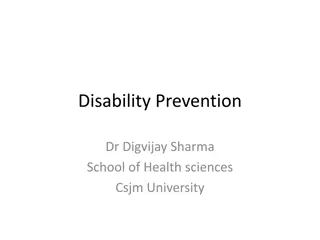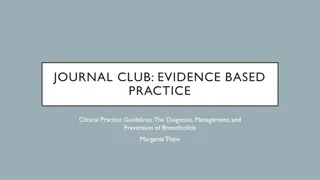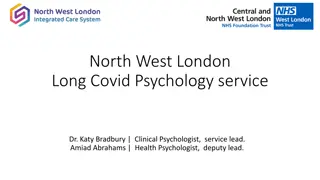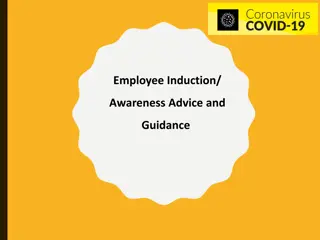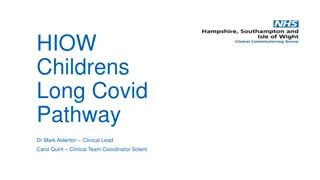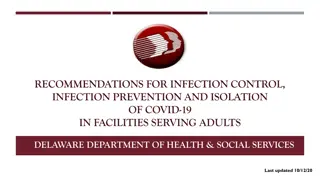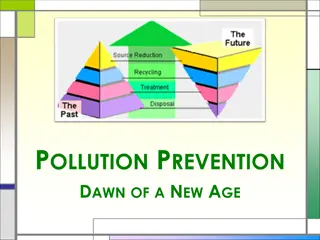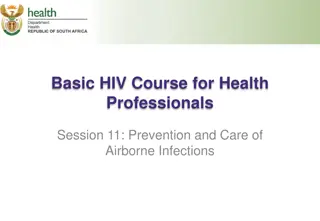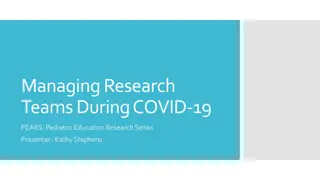Updated COVID-19 Prevention Measures and Guidelines
This includes updates on transmission, preventative actions, vaccination importance, high-risk individuals, symptoms, and infection prevention in non-US healthcare settings. The presentation emphasizes CDC and WHO guidance, with references and links provided for detailed information.
Download Presentation

Please find below an Image/Link to download the presentation.
The content on the website is provided AS IS for your information and personal use only. It may not be sold, licensed, or shared on other websites without obtaining consent from the author.If you encounter any issues during the download, it is possible that the publisher has removed the file from their server.
You are allowed to download the files provided on this website for personal or commercial use, subject to the condition that they are used lawfully. All files are the property of their respective owners.
The content on the website is provided AS IS for your information and personal use only. It may not be sold, licensed, or shared on other websites without obtaining consent from the author.
E N D
Presentation Transcript
Summary of Changes Updated transmission slide to reflect CDC guidance (linked on slide) Expanded the preventative actions slide by including one on vaccination. Since this PPT is meant for non-US settings, the slide was added to emphasize the preventative action of getting vaccinated but to also continue other preventative actions Added a slide on circumstances that could increase the risk of becoming infected with COVID-19 and added references to CDC and WHO on ventilation guidance Added a preventative slide describing the wearing of masks to reflect CDC guidance (linked on slide) Updated symptoms list based on WHO reference (linked on slide) Added additional preventative slide to emphasize the importance of other preventative actions in addition to vaccination and mask wearing Updated People at higher risk slide to reflect WHO and CDC guidance on those at higher risk for severe COVID-19 illness including the mention that those at higher risk should be prioritized for vaccination (references linked on slide) Added a slide to describe IPC in the context of vaccination delivery based on WHO guidance (linked on slide) Updated the list of AGPs currently listed in WHO guidance (linked on slide)
COVID-19 Overview and Infection Prevention and Control Priorities in non-US Healthcare Settings Document can be found at: https://www.cdc.gov/coronavirus/2019- ncov/hcp/non-us- settings/overview/index.html cdc.gov/coronavirus
Outline Coronavirus Background Coronavirus Disease 2019 (COVID-19) Emergence of COVID-19 Transmission Symptoms COVID-19 Prevention and Treatment Infection Prevention and Control (IPC) for COVID-19
Coronaviruses (CoV) Coronaviruses are a large family of viruses that can cause illness in animals or humans In humans, several known coronaviruses can cause respiratory infections Ranging from the common cold to more severe diseases such as severe acute respiratory syndrome (SARS), Middle East respiratory syndrome (MERS) and coronavirus disease 2019 (COVID-19)
COVID-19: Emergence Identified in Wuhan, China in December 2019 COVID-19 is caused by the virus SARS-CoV-2 Early in the outbreak, many patients were reported to have a link to a large seafood and live animal market Later, no link to the market indicating person-to-person spread of the disease Travel-related exportation of cases reported https://www.healthpolicy-watch.org/
COVID-19: Transmission There are three main ways that COVID-19 can be spread: 1. Breathing in air when close to an infected person who is exhaling small droplets and particles that contain the virus 2. Having small droplets and particles that contain virus land on the eyes, nose or mouth - especially through splashes and sprays like a cough or sneeze 3. Touching the eyes, nose or mouth with hands that have virus on them CDC Guidance: How COVID Spreads
COVID-19: Circumstances that can increase risk Poor ventilation In enclosed and poorly ventilated space, the amount of virus in the air can build up and cause infections further away from an infectious space1,2 Prolonged exposure to someone who might be infected Close contact less than 1.8 meter (6 ft)* Activities that lead to exposure to a greater amount of respiratory fluids (i.e. aerosol generating procedures) * Based on CDC recommendation. WHO recommends at least 1 meter apart 1CDC Guidance: Ventilation in Buildings , 2 WHO Roadmap to improve and ensure good indoor ventilation in the context of COVID-19
COVID-19: Symptoms Wide range of symptoms reported* Fever or chills Cough Muscle or body aches Anorexia Sore throat Nasal congestion or runny nose Headache Diarrhea Nausea Shortness of breath or difficulty breathing Loss of smell or taste *COVID-19 Clinical management: living guidance Estimated incubation period: 2 to 14 days
COVID-19: People at higher risk for severe illness In some cases, people who get COVID-19 can become seriously ill and develop difficulty breathing These severe complications can lead to death The risk of severe disease increases steadily as people age Those of all ages with underlying noncommunicable diseases, such as diabetes & cardiac disease, appear to be at higher risk to develop severe COVID-19 compared to those without these conditions Those at higher risk should be prioritized for vaccination* As more data become available, additional risk factors for severe COVID-19 may be identified *WHO SAGE Roadmap for Prioritizing COVID-19 Vaccines in the context of limited supply WHO COVID-19 Clinical Management: living guidance CDC COVID-19 Underlying Medical Conditions
COVID-19: Preventative actions vaccination Get vaccinated Be sure to check that your country is offering the vaccine and you are eligible Safe and effective vaccines are a great tool for prevention, but it is important to continue other preventative actions, such as wearing masks, hand hygiene, cough etiquette especially as new COVID-19 strains emerge and vaccination coverage in some countries continue to be low. There are several vaccine candidates, and many have been listed under WHO s emergency use
COVID-19: Preventative actions - masks Wear masks that*: Have two or more layers of washable, breathable fabric Completely cover the nose and mouth Fit snug against the sides of the face and not have gaps Have a nose wire to prevent air from leaking out of the top of the mask It is important to determine and wear the appropriate type of mask based on the setting *CDC Guide to Masks
COVID-19: Other preventative actions to continue Stay at least 1.8 meters*, or further, apart from others Avoid crowded spaces and spaces with poor ventilation Perform hand hygiene Keep high-touch surfaces clean Monitor symptoms and get tested if ill *1.8 meter based on CDC recommendations. WHO recommends at least 1 meter apart
What is IPC? The practice of preventing or stopping the spread of infections during healthcare delivery Hospitals, outpatient clinics, dialysis centers, long-term care facilities, traditional practitioners IPC Goal for COVID-19: To support the maintenance of essential healthcare services by containing and preventing COVID-19 transmission within healthcare facilities to keep patients and healthcare workers healthy and safe
COVID-19: IPC Priorities Rapid identification of suspect cases Screening/triage at initial healthcare facility encounter and rapid implementation of source control Limiting entry of healthcare workers and/or visitors with suspected or confirmed COVID-19 Immediate isolation and referral for testing Group patients with suspected or confirmed COVID-19 separately Test all suspected patients for COVID-19 Safe clinical management Immediate identification of inpatients and healthcare workers with suspected COVID-19 Adherence to IPC practices Appropriate personal protective equipment (PPE) use Strategic Priority IPC Activities for Containment and Prevention
COVID-19: IPC in the context of vaccination delivery Key IPC measures should be implemented for vaccine delivery* Hand hygiene All staff on arrival and leave, should wash their hands with soap and water Functioning hand hygiene stations should be available PPE Staff administering vaccine should wear a medical mask and individual receiving vaccine should wear a medical or fabric mask Injection safety Perform hand hygiene before preparing injection materials Pierce the septum with a sterile needle every time it is used Environmental cleaning and waste management Discard used syringes as a single unit into a sharps container immediately Perform regular environmental cleaning and disinfection of areas at least twice daily *WHO IPC principles and procedures for COVID-19 vaccination activities
Standard and Transmission-Based Precautions Standard Precautions Set of practices that apply to care of all patients in all healthcare settings Transmission-Based Precautions Set of practices specific for patients with known or suspected infectious agents that require additional control measures to prevent transmission Used in addition to Standard Precautions
Standard Precautions Hand hygiene Personal protective equipment (PPE) Respiratory hygiene and cough etiquette Cleaning and disinfection of devices and environmental surfaces Safe injection practices Medication storage and handling
COVID-19: Transmission-Based Precautions Wear PPE for contact and droplet precautions* Unless an aerosol-generating procedure is performed, in which case airborne precautions are needed Use disposable or dedicated patient care equipment (e.g., stethoscopes, blood pressure cuffs) If equipment needs to be shared among patients, clean and disinfect it between use for each patient by using ethyl alcohol of at least 70% *WHO Infection prevention and control during healthcare when COVID-19 is suspected or confirmed
COVID-19: Transmission-Based Precautions Use adequately ventilated single rooms (preferable) or dedicated COVID-19 ward rooms with dedicated bathrooms Bathrooms should be cleaned and disinfected twice daily Avoid transporting COVID-19 patients out of room unless medically necessary Place a mask on COVID-19 suspected or confirmed patients if transport out of a room is medically necessary Healthcare workers should wear appropriate PPE during transport* Designate healthcare workers to care for patients with COVID-19 Restrict the number of visitors allowed *WHO Rational Use of personal protective equipment for COVID-19
COVID-19: PPE Healthcare workers should: Use a medical mask (i.e., at least a surgical/medical mask) N95 respirator in units where aerosol-generating procedures are performed Wear eye protection (goggles) or facial protection (face shield) Wear a clean, non-sterile, long-sleeved gown Use gloves Healthcare workers should be trained on correct use of PPE, including putting on and taking off PPE Extended use and re-use of certain PPE items (e.g., mask, gown) can be considered if supply shortage Risk of self-contamination is high when removing PPE Instructions for putting on and removing PPE
Aerosol-Generating Procedures* PPE Recommendations for aerosol-generating procedures performed on COVID-19 patients: Endotracheal intubation Bronchoscopy Non-invasive ventilation Tracheotomy Manual ventilation before intubation Cardiopulmonary resuscitation Sputum induction A fitted respirator (N95, FFP2, or equivalent) as opposed to surgical/medical masks Gloves Long-sleeved gown Eye protection (goggles/face shield) *current list provided by WHO - COVID-19 Clinical management: living guidance
Infection Prevention and Control Resources for COVID-19 in non-US Healthcare Settings Strategic Priority IPC Activities for Containment and Prevention Triage SOP Identification of Healthcare Workers and Inpatients with Suspected COVID-19 Management of Visitors to Healthcare Facilities Interim Operational Considerations for Public Health Management of Healthcare Workers Exposed to or Infected with COVID-19 Operational Considerations in Outpatient Facilities
For more information, contact CDC 1-800-CDC-INFO (232-4636) TTY: 1-888-232-6348 www.cdc.gov The findings and conclusions in this report are those of the authors and do not necessarily represent the official position of the Centers for Disease Control and Prevention.
